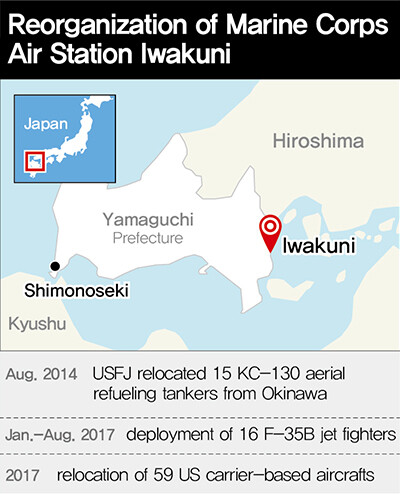hankyoreh
Links to other country sites 다른 나라 사이트 링크
US Forces Japan aviation power moves to counter China and North Korea

Next year, US Forces Japan (USFJ) is expected to wrap up a plan that will concentrate cutting-edge aviation assets with the Marine Corps and the Navy in western Japan, closer to China and North Korea.
Once the plan is complete, Marine Corps Air Station Iwakuni, which is located in Yamaguchi Prefecture, is expected to become the front-line base on the Japanese mainland tasked with countering China and North Korea.
On Aug. 23, Japanese media reported that Parliamentary Vice-Minister for Foreign Affairs Shunsuke Takei and Parliamentary Vice-Minister of Defense Hiroyuki Miyazawa had informed Yoshihiko Fukuda, mayor of Iwakuni, of plans to deploy the US army’s top-of-the-line F-35B stealth fighter at the USFJ base in Iwakuni by January of next year.
According to the plan, 10 F-35B fighters will be deployed at the Iwakuni base by Jan. 2016 and six more by August. Unlike the F-35A, which is intended for ordinary air force operations, and the F-35C, which is launched from aircraft carriers, the F-35B is capable of vertical take-off and landing
But that‘s not all. As part of the USFJ reorganization plan that the US and Japan have been implementing, 59 deck-launched FA-18 Hornets and Super Hornets that had been assigned to the USS Ronald Reagan (an aircraft carrier deployed to Yokosuka, the home of the US Seventh Fleet) will be relocated from Naval Air Facility Atsugi in Kanagawa Prefecture to the Iwakuni base.
Until now, the Atsugi base, which is near Yokosuka, had served as the ground base for the maintenance and training of these deck-launched fighters, but they are effectively being moved to western Japan.
In Aug. 2014, USFJ relocated 15 KC-130 aerial refueling tankers that had been based in Okinawa to Iwakuni.
These movements are thought to be natural steps that the US and Japan alliance is taking to counter the threat of North Korean nuclear weapons and missiles and China’s maritime ambitions.
At the US-Japan Security Consultative Committee (2+2) in Oct. 2013, during which the US first welcomed Japan’s right to exercise collective self-defense, the US announced plans to forward deploy the F-35B (a fighter that was still under development at the time) to Japan in 2017, the first time it would be deployed outside of the US.
F/A-18 Hornets and AV-8 Harriers attached to the Marine Corps are still based at Iwakuni today. The F-35B, which will begin to be deployed in January, is supposed to replace these fighters.
The deployment of the F-35B at Iwakuni is expected to have a ripple effect on relations in East Asia, as a tense struggle continues between the US-Japan alliance and China.
In addition to its advanced stealth capabilities, the F-35B has an operational radius of more than 1,000km. The fighter can also be equipped with JASSM (Joint Air-to-Surface Standoff Missile) missiles, which have a range of 370km.
F-35B fighters launched from the Iwakuni base would effectively be capable of targeting North Korean bases that have launched ballistic missiles. In addition, F-35B fighters could land on Japanese light carriers like the Izumo for reloading and refueling.
In Sep. 2015, the Japanese government revised the relevant legislation to enable it to provide the US military with this kind of rear support.
The F-35B could also be used to check China. The American amphibious assault ships that would operate this fighter are stationed in the city of Sasebo in Nagasaki Prefecture. By monitoring the extensive area of the East China Sea and the South China Sea, US Marine Corps amphibious assault ships carrying F-35B fighters would effectively be able to check China’s maritime expansion.
And with 15 KC-130 aerial refueling tankers deployed to the Iwakuni base, the F-35B’s range of activity can be expanded enormously.
By Gil Yun-hyung, Tokyo correspondent
Please direct questions or comments to [english@hani.co.kr]

Editorial・opinion
![[Column] Has Korea, too, crossed the Rubicon on China? [Column] Has Korea, too, crossed the Rubicon on China?](https://flexible.img.hani.co.kr/flexible/normal/500/300/imgdb/original/2024/0419/9317135153409185.jpg) [Column] Has Korea, too, crossed the Rubicon on China?
[Column] Has Korea, too, crossed the Rubicon on China?![[Correspondent’s column] In Japan’s alliance with US, echoes of its past alliances with UK [Correspondent’s column] In Japan’s alliance with US, echoes of its past alliances with UK](https://flexible.img.hani.co.kr/flexible/normal/500/300/imgdb/original/2024/0419/2317135166563519.jpg) [Correspondent’s column] In Japan’s alliance with US, echoes of its past alliances with UK
[Correspondent’s column] In Japan’s alliance with US, echoes of its past alliances with UK- [Editorial] Does Yoon think the Korean public is wrong?
- [Editorial] As it bolsters its alliance with US, Japan must be accountable for past
- [Guest essay] Amending the Constitution is Yoon’s key to leaving office in public’s good graces
- [Editorial] 10 years on, lessons of Sewol tragedy must never be forgotten
- [Column] A death blow to Korea’s prosecutor politics
- [Correspondent’s column] The US and the end of Japanese pacifism
- [Guest essay] How Korea turned its trainee doctors into monsters
- [Guest essay] As someone who helped forge Seoul-Moscow ties, their status today troubles me
Most viewed articles
- 1[Column] The clock is ticking for Korea’s first lady
- 2After 2 months of delayed, denied medical care, Koreans worry worst may be yet to come
- 3Hong Se-hwa, voice for tolerance whose memoir of exile touched a chord, dies at 76
- 4Samsung barricades office as unionized workers strike for better conditions
- 5[Column] Has Korea, too, crossed the Rubicon on China?
- 6US overtakes China as Korea’s top export market, prompting trade sanction jitters
- 7[Editorial] As it bolsters its alliance with US, Japan must be accountable for past
- 8[Correspondent’s column] In Japan’s alliance with US, echoes of its past alliances with UK
- 9All eyes on Xiaomi after it pulls off EV that Apple couldn’t
- 10[Guest essay] How Korea turned its trainee doctors into monsters